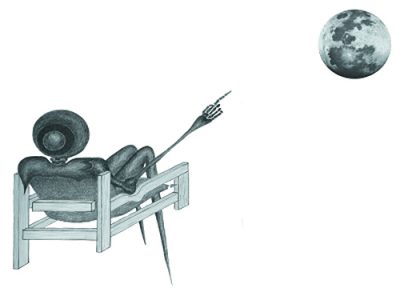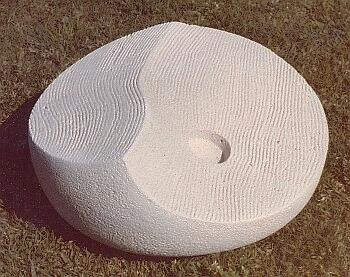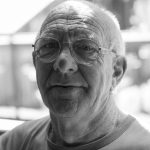Finger Pointing At The Moon – pencil drawing Rob Harle
A long conversation with Sunil Sharma
Rob Harle is a saint for some; an iconoclast for others. One thing is sure. The Nimbin Valley-based Australian artist working with multi-media loves to subvert the system and is impatient with the boorish and pretentious flourishing in the world of arts, theories and the academe. As a visual and verbal artist, he has made transitions at important stages of an evolving and rich career as a full-time poet-painter-reviewer-editor.
Here is the interview with the senior savant on art, aesthetics and life:
Q: Zen has fascinated the West for long. What are the reasons?
A: Zen has a kind of mysteriousness about it. It is the anti-thesis of the Western approach to life which seems to think that “more is better” – more decoration, more possessions, more words. Generally we could say Zen action is minimalist and Western action is maximalist. So the mysterious Other has an attraction, an alternative way of perceiving the world and acting in the world. Also because the myths that construct the monotheistic religions, especially Christianity, are starting to be seen for what they are. Individuals are now looking towards a spiritual system, Zen Buddhism, which doesn’t carry as much incredulous baggage/doctrine as the dominant Western religions and even some secular philosophies.
Q: Zen insists on the intuitive side. An interesting parallel is, for me, the logocentric critique of Derrida. Do you see some similarities also?
A: Yes most definitely. I can’t think of any philosophy that is as antithetical to Zen as Derrida’s. Words, words, more analysis of words; vacuous intellectual masturbation is the main characteristic of Derrida’s philosophy. Zen has no real need of words. From a very early evolutionary perspective early humans communicated in the “here-and-now” prior to language acquisition and development. Direct experience is the essence of Zen, intellectual analysis and deconstruction of words, their sounds, their signification has no relevance to Zen as such. Derrida et al have done humanity a great disservice in pushing us further away from “direct experience” of the “here-and-now”. As the saying goes: “Derrida leaves us with nothing, Zen leaves us with no-thing!”
Q: Grounded in comparative religion, as an artist scholar, when did you make transition from the Western rational epistemology to the intuitive one of Zen?
A: I escaped the “rat-race” of city living in 1976 (I was 28) to pursue a quiet, contemplative, creative life in the bush – much more in tune with nature. Like many Westerners my first introduction to Zen was through books by Christmas Humphries, Alan Watts, Eugene Herrigal, Basho and even Zen & The Art of Motorcycle Maintenance – an extremely influential book in my life. It then followed that I approached my serious, full-time development as a sculptor in the way of Zen, the ensuing sculptures were created for contemplation, in natural settings, and carved directly in wood or stone, or made from clay (ceramics). A Zen master in my opinion, Kevin Flanagan, was a mentor and taught me about Fire, Air, Earth and Water. I wrote a tribute poem about him prior to his tragic, unnecessary premature death. Here it is”
Homage To The Mud Dauber Man
Through the filigree of space inspiration
comes in odd and other ways. Sometimes
we seek it in seclusion, sometimes it
comes by chance. It can rest for a
surface second, like Chuang Tzu’s butter-
fly, or penetrate us deeply like the
sting of a wasp; indelible through time.
Too many years ago, surrounded by mud and
fragrant eucalypts, I met a mentor of a
man. He lit a blazing candle and I
perceived a world unknown. He loved all
frogs and was a man of Zen. The frog
chose my friend to use it as his symbol,
long before he ever heard of Zen. Totems
must choose their partners else they have
no fire or inspiration. His frogs are
full of life. They dive into inner space
defined by curve of clay or simply rest a
while upon the rim of pot and urn. With
smiles they watch their maker play with
dust and fire. We understand the way of
the potter-artist in watching silently
the wasp, though they remain the masters,
sure. My friend is a mud-dauber in disguise
with dexterity, intuition and the
single minded purpose of the little black
and orange dart. We shared the sun and
shadows and invented new realities until
the wine ran dry at midnight. But a
liaison of wasp and spider strains under
the threat of Damocles’ sword. Now we’ve
gone our wandering ways, and he transforms the
the fire and earth and I the fire and air.
Q: Was it tough? Going from a Cartesian position to that of Alan Watts, John Cage and Daisetz Taitaro Suzuki?
A: No not at all! It was like winning the lottery or coming home after a long absence. Even though I was brought up and educated in a “Cartesian”, and I would add Platonically influenced society, it never rang true from an early age, perhaps 6 or 7. The incoherent garbage I was fed at Sunday School – such as the literal interpretation of the Bible drove me away from Christianity for good. A shame really because all spiritual/religious systems have positive uplifting aspects. Watts and Suzuki were like pure nectar – Cage is a different matter all together (too much to add here about him).
Q: What is the most appealing element of Zen as a global philosophy?
A: Firstly Zen is not synonymous with Zen Buddhism. Zen is Zen, Zen Buddhism is Zen + the baggage of Buddhism. Hmmm! Honesty, sincerity, reliance on self (not an external puppet master). Clarity of perception and living harmoniously with nature not dominating and raping her.
Q: What are the connections between Zen and arts?
A: A person who lives a Zen lifestyle brings a certain approach to everything they do – so cooking, walking in the forest, making a painting or sculpture are all underpinned by spontaneous expression, letting the activity “perform itself” so to speak. So the Western approach to say creating an oil painting by sketching, making notes, preliminary studies and so on is not the way of Zen. Learning a technique until mastered, say throwing a clay pot, and only after perfecting that, attempting to make a finished pot is an example of the Zen approach. Spontaneous watercolor painting or writing down a haiku poem is more Zen than a totally planned traditional Western oil painting. This is not to say Western artists don’t have a Zen approach, many of the best do, just that it is not the dominant way.
Q: How do you as a poet view Haiku? Is it possible to import this form outside of its historical framework and work for a foreign culture?
A: Very good question. I don’t think the concept “imports” well, firstly our way of perceiving the world is literally different from the Oriental way (especially China and Japan). Secondly, any old 3 line, 17 syllable bunch of words is not automatically a haiku, let alone a good one. Most Western haiku leaves me unmoved; there are a few wonderful exceptions. The poets I know who write haiku live a life employing the sensibilities of the Oriental nature haiku poets.
Q: Is there a conflict between Zen view of art as something concerned with the essence of things rather than linguistic and symbolic representation and the Western formalism?
A: This is a complex question, the answer is both Yes and No. Although Zen art’s main intention is to capture the essence it is still often representational. The ink/brush painting of bamboo for example. Not a great deal of difference between this and a Western still life in oils or a vase of flowers, from a representational point of view. Western formalist painting is so vast it’s hard to generalise. I will say though that some of the West’s genres – abstract expressionism (a la Pollock) for example get closer to the essence of things than Zen landscape paintings. Likewise Western minimalist sculpture (Serra, Brancusi) and so on. Rather than suggesting conflicts perhaps better to say difference. A huge opportunity for future research here?
Q: As a leading artist from Australia—and a recent global figure—how do you reconcile the two disparate strands of the Oriental and Occidental aesthetics in your works?
A: That’s fairly easy. My sculpture and ceramic work was influenced and inspired by Oriental aesthetics almost completely. My digital techno-surrealist images are probably more occidental, though I don’t really think they fit either that well. The aesthetics of minimalist composition are characteristic of this work. The works proceed intuitively, encourage “happy accidents”, and the work dictates to me what will happen next. These are always present but I still think this is a feature of both East and Western aesthetics.
Q: Zen is anti-intellectual, anti-canon and anti-official in its general reflections. In fact, it denies authority and relies on individual meditation and discovery on and of truth. Western art is canonical and invariably official and after the Renaissance, status quoits. Your views?
A: The first part of your question is fairly accurate but the second section is only part of the story. Think of Rodin, then Dada, Surrealism, Duchamp and Cubism – all breaking with the status quo, blowing away the received canon (pun intended) and totally unofficial. Then the work of Pollock and Warhol et al, in fact I would suggest most Western art since the early 1900s is more anti-canon, anti-official and status quo destroying than its rather staid Oriental counterpart.
Q: Through Zen art, can we glimpse the spiritual?
A: Yes indeed! If we are content to think of spiritual as synonymous with essence. But then much Western art has the same impact, think of The Pieta by Michelangelo in St. Peter’s basilica.
Q: The Nimbin Valley in New South Vales Australia—where you live with your Mandala-artist spouse Sandra Joran—is home to a bunch of artists with varied backgrounds. There are psychic readers and Tarot card readers. It is an interesting commune of the Other. Your experience?
A: Nimbin Valley is like no other place I’ve experienced (limited as this is).There may be one or two other places in Australia a little like Nimbin. It’s a “free range psychiatric village”. Everyone from true geniuses, brilliant musicians, inventors, artists/writers, sustainable food growers, down-and-out losers of the worst kind, drop-outs etc. I have a love-hate relationship with Nimbin – the positive side is ecstasy (not the drug!) and the negative side is agony. It’s a place where refugees, fringe dwellers, eccentrics and anti-establishment people of all races, colours, genders live and are freely accepted.
Q: What are your current preoccupations?
A: Continuing book/manuscript review work; two thirds finished my next volume of poetry Winds of Infinity; experimenting with a new image producing technique.
Q: You plan to start new innings as a painter with different tools. Any reason for opting high-tech means for self-expression?
A: My existing method of creating techno-surrealist digital artwork is fairly high-tech but it has reached a zenith. I’m very conscious of the possibilities of falling into the trap that ensnares many older (senior, mature) artists producing more of the same work with slight cosmetic differences. Boring! It is a very hard “call” to keep creating genuine, vibrant, inspired new work, it is so hard in fact that many artists (of all disciplines) just get tired and give up, losing “the rage” so to speak. I want to add a more flowing, ethereal, mysterious element to my artwork so fibre-optic light painting may just be the thing. I was stunned by a portrait in National Geographic Magazine while waiting at the dentists of all places. A fair bit of research and emailing found out how it was created – stand by for action.
Q: Can Zen aesthetics work in global markets of art production and circulation.
A: No different to any other art work really. Very few “genuine” artists make a decent living from their art. Art is about “the doing” not producing a saleable product.
Q: Zen in your words.
A: A wonderful non-doctrinal philosophy to help make this absurd existence tolerable. It helps one see into the “heart of the matter”, past the fast-paced superficial gloss of the “affairs of mice and men (and women)”.
Q: Zen art in a few one-liners?
A: “We know the labels on all the bottles but never taste the wine.”
“How wondrously strange and marvellous: I draw water and carry fuel.”
“Sculpture is 4 dimensional poetry existing in silence.”
“The process of Zen is a leap from thinking to knowing, from secondhand to direct
experience.”
This last statement is reflected in my artwork at the beginning of this interview. This is a pencil drawing I did many years ago and is entitled Finger Pointing At The Moon. Zen warns us not to mistake the pointing finger for the moon itself. Direct experience is what’s important!
Q: Can we attempt successfully the formlessness of Zen art by departing from a strong Aristotelian-Cartesian tradition?
A: Yes absolutely. In fact we must forget all that, everything about blasted Descartes! Delete! Delete!
Q: Your fav Zen masters?
A: No favourites, that would be a bit anti-Zen. but great influences Dogen, D.T. Suzuki, Robert Aitken, Kevin Flanagan and Basho.
Q: Can art be a gateway to mysticism? The kind you experience reading Tolstoy? Or Homer?
A: Absolutely, I think that the very best art is in fact partly, if not fully, mystical in its influence. That is, the artwork may not have an overt mystical intention but if it doesn’t take the viewer/reader to a “higher” dimension (of mind, reality, whatever) then it is poor art or “pot boiler” commercial art. This is why the great masters’ works endure and are an endless source of mystical/spiritual/higher consciousness satisfaction.
Q: What is the role of nature on your inner world?
A: Without me literally being part of nature, and it being part of me, (the whole natural world – not man made things) then I’m “out-of-here”! It is incomprehensible to me to not be immersed in the natural world. This has been so since my earliest memories (around 3 years old) – sleeping and hiking in the forest, surfing/sailing/swimming in the ocean, growing plants and gardens, nurturing wildlife etc.
Q: What is the current Australian artistic scene?
A: I couldn’t care less really, but pathetic generally! It is still in the dying throws of postmodernism, mostly behind the rest of the world as usual. One or two exceptions are happening such as the art scene at the University of Western Australia.
Q: Charles Simic is an enduring influence on you. This affinity and its reasons?
A: Simic is a true, genuine poet. Existentially authentic is my belief in his approach to poetry and literature. He tends towards brevity, saying in a few poignant words that which others need lines to say. I also like the Surreal feeling and content of much of his poetry. His poetry is kind of minimalist with a Zen feeling but I don’t believe his work is specifically influenced by Zen as such. He is an intellectual and has spent many years developing, understanding and teaching poetry. Then out of that comes the magical, Zen-like poems, an enigma, quite unique I think.
Q: Your philosophy these days?
A: Maintain the rage; do anything in my artistic/literary power to protect what’s left of the natural world; support the new art and poetics starting to happen in this post postmodern era which will help restore our abandoned metaphysical and spiritual modes of being. This art, also now in the postdigital age, must re-humanise the technology of the digital. We need to embrace sustainability and re-envisage the “mysterium, temendum et fascinans”, if we do not, humanity as we know it is finished!; to keep at bay, the best I can, the vacuous, mercenary, dumbed-down, global, I-Me-Mine mindset.
Q: What would you tell younger artists?
A: Learn your “technique” well (a Zen truism); stay totally clear of abstruse art/literary theory (especially postmodernism); ask yourself. “Am I inspired and passionate about my artwork (whichever genre this may be) if so you will succeed! You may not be famous, you may not be wealthy from your art, but you’ll have true success. “Better to create art for yourself and have no public, than to create art for the public and have no self!”
Q: Thanks.
A: Pleasure Sunil, thanks for the provocative questions 🙂
Rob Harle
Rob Harle is an artist, poet and researcher.
Past artwork consisted of drawing and sculpture – current work is exclusively digital/computer created images.
Writing work includes both film & book reviews, poetry and academic essays. These are published in numerous journals, magazines and books.
His formal academic studies comprise: Philosophy of Mind, Comparative Religion, Architecture and Psychotherapy.
His immediate past work has been concerned with the technoMetamorphosis – the social and evolutionary impact of technology, including the nature of consciousness, embodiment and techno-augmentation. This has given way to a (re)exploration of the surreal nature of existence through the archetypal shadows of the Collective Unconscious. One recent critic used the term techno-surrealism to describe his work.
He is an active member of Leonardo, and an editorial member of The Journal of Fine & Studio Art and The Journal of Virtual World Research.
Artwork & selected writings are available from his website www.robharle.com





An interesting read. I felt totally out of my depth but not drowning.
Very very impressive-both, the interviewer n the interviewee!!
Throughly enjoyed the interview. Both the interviewer and the interviewee are in good form. Wise and well thought-out questions have been answered in a sagacious and sharp manner.May we have more such interviews by Sunil Sharma.